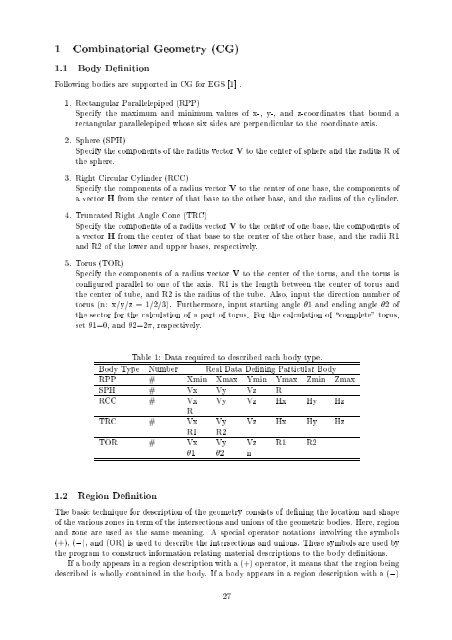cg Version
cg Version
cg Version
You also want an ePaper? Increase the reach of your titles
YUMPU automatically turns print PDFs into web optimized ePapers that Google loves.
1 Combinatorial Geometry (CG)1.1 Body DenitionFollowing bodies are supported in CG for EGS [1] .1. Rectangular Parallelepiped (RPP)Specify the maximum and minimum values of x-, y-, and z-coordinates that bound arectangular parallelepiped whose six sides are perpendicular to the coordinate axis.2. Sphere (SPH)Specify the components of the radius vector V to the center of sphere and the radius R ofthe sphere.3. Right Circular Cylinder (RCC)Specify the components of a radius vector V to the center of one base, the components ofavector H from the center of that base to the other base, and the radius of the cylinder.4. Truncated Right Angle Cone (TRC)Specify the components of a radius vector V to the center of one base, the components ofa vector H from the center of that base to the center of the other base, and the radii R1and R2 of the lower and upper bases, respectively.5. Torus (TOR)Specify the components of a radius vector V to the center of the torus, and the torus iscongured parallel to one of the axis. R1 is the length between the center of torus andthe center of tube, and R2 is the radius of the tube. Also, input the direction number oftorus (n: x/y/z = 1/2/3). Furthermore, input starting angle 1 and ending angle 2 ofthe sector for the calculation of a part of torus. For the calculation of \complete" torus,set 1=0, and 2=2, respectively.Table 1: Data required to described each body type.Body Type Number Real Data Dening Particular BodyRPP # Xmin Xmax Ymin Ymax Zmin ZmaxSPH # Vx Vy Vz RRCC # Vx Vy Vz Hx Hy HzRTRC # Vx Vy Vz Hx Hy HzR1 R2TOR # Vx Vy Vz R1 R21 2 n1.2 Region DenitionThe basic technique for description of the geometry consists of dening the location and shapeof the various zones in term of the intersections and unions of the geometric bodies. Here, regionand zone are used as the same meaning. A special operator notations involving the symbols(+), (;), and (OR) is used to describe the intersections and unions. These symbols are used bythe program to construct information relating material descriptions to the body denitions.If a body appears in a region description with a (+) operator, it means that the region beingdescribed is wholly contained in the body. If a body appears in a region description with a (;)27









